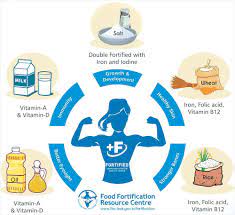Food Fortification:

The Food Safety and Standards Authority of India’s (FSSAI’s) Food Fortification Resource Centre (FFRC) has reported that over 70% of India’s population consumes less than half the daily recommended dietary allowance of micronutrients.
- These deficiencies are prevalent not only in women and children from rural areas but also affect population groups in urban India.
- In a bid to directly address anaemia and micronutrient deficiency in the country, the Centre recently approved a pilot scheme on “Fortification of Rice & its Distribution under Public Distribution System”.
- The government’s food fortification initiative is already taking shape with several states, including Andhra Pradesh, Gujarat, Maharashtra, Tamil Nadu, Chhattisgarh, Uttar Pradesh, Odisha, Telangana, Uttarakhand and Madhya Pradesh, starting the distribution of fortified rice under the pilot programme.
- Fortifying staple foods and condiments with key micronutrients is an effective way of addressing deficiencies.
- Timely adoption of food fortification in social and nutrition security programmes as a part of the fortification initiative will play a crucial role in addressing undernutrition in India.
- The country has high levels of malnutrition among women and children.
- According to the Food Ministry, every second woman in the country is anaemic and every third child is stunted.
- India ranks 94 out of 107 countries and is in the ‘serious hunger’ category on the Global Hunger Index (GHI).
- Malnutrition and lack of essential nutrients in poor women and poor children poses major obstacles in their development.
Food fortification :
- It is defined as the practice of adding vitamins and minerals to commonly consumed foods during processing to increase their nutritional value.
- It is a proven, safe and cost-effective strategy for improving diets and for the prevention and control of micronutrient deficiencies.
- The Food Safety and Standards Authority of India (FSSAI), defines fortification as “deliberately increasing the content of essential micronutrients in a food so as to improve the nutritional quality of food and to provide public health benefit with minimal risk to health”.
- According to the Food Ministry, fortification of rice is a cost-effective and complementary strategy to increase vitamin and mineral content in diets.
- According to FSSAI norms, 1 kg fortified rice will contain iron (28 mg-42.5 mg), folic acid (75-125 microgram) and Vitamin B-12 (0.75-1.25 microgram).
- In addition, rice may also be fortified with micronutrients, singly or in combination, with zinc (10 mg-15 mg), Vitamin A (500-750 microgram RE), Vitamin B1 (1 mg-1.5 mg), Vitamin B2 (1.25 mg-1.75 mg), Vitamin B3 (12.5 mg-20 mg) and Vitamin B6 (1.5 mg-2.5 mg) per kg.
- Since the nutrients are added to staple foods that are widely consumed, this is an excellent method to improve the health of a large section of the population, all at once.
- Fortification is a safe method of improving nutrition among people. The addition of micronutrients to food does not pose a health risk to people.
- It does not require any changes in food habits and patterns of people. It is a socio-culturally acceptable way to deliver nutrients to people.
- It does not alter the characteristics of the food—the taste, the feel, the look.
- It can be implemented quickly as well as show results in improvement of health in a relatively short period of time.
- This method is cost-effective especially if advantage is taken of the existing technology and delivery platforms.




